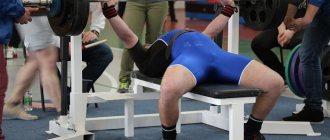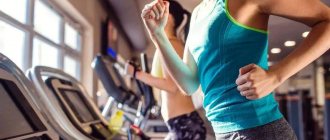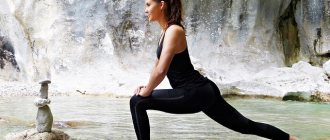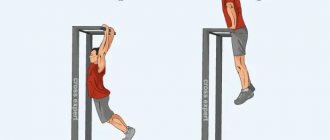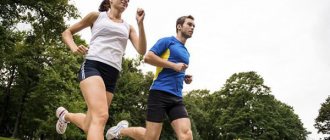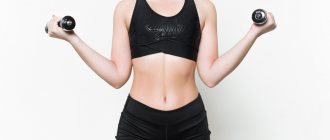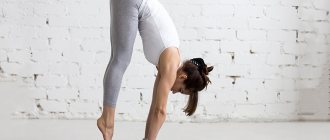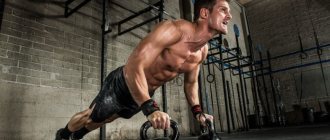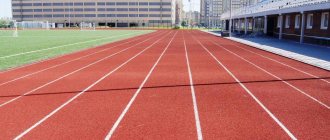You can often observe the following situation in gyms: an experienced bodybuilder with huge muscles squats with a barbell. At the same time, he manages to get up with great difficulty. And then the same barbell is lifted by a person whose muscles don’t seem so big. But he squats quite easily.
The fact is that strength does not always directly depend on muscle volume. Professional powerlifter, two-time world champion Sergei Skolsky
.
Abs in 21 days: a bold challenge from Arina Skoromnaya
Strength or endurance: what is more important?
A weightlifter is superior to a track and field athlete in physical strength, but over a long distance he may not reach the finish line. He simply does not have enough endurance, and without it he will not be able to develop strength. The athlete will not be able to withstand intense training loads.
Strength is overcoming external resistance, moving a heavy weight from one point to another. The higher the resistance overcome, the stronger the person. Such loads are useful for building muscles.
Endurance is the performance of certain actions over a long period of time. A good example is marathon running of 40 kilometers or more, or the ability to hold a plank for 40-60 minutes.
The conclusion is obvious: physical strength and endurance are interconnected, both abilities need to be trained. Pile of muscle is of little use if the athlete has problems with endurance.
Types and features of structure
All muscles in the human body are divided according to the principle of contraction speed and resistance to fatigue. So, they distinguish:
- glycolytic (rapid contraction - rapid fatigue);
- intermediate (fast contraction - slow fatigue);
- oxidative (slow contraction - slow fatigue).
Now let’s talk about each type of muscle in more detail. The first - glycolytic fibers are distinguished by a small number of capillaries in their composition. They are white in color and respond quickly enough to impulses coming from the brain. Creatine phosphates, glycogen and ATP as energy sources in glycolytic fibers are processed 2-3 times more actively. However, the depletion of these substances occurs quickly, so this type of muscle is prone to fatigue. White fibers are designed for short-term, but high-intensity loads. Repeated exercises are unacceptable for them. They also tend to grow and increase in size due to delamination. By the way, the increase in muscle mass by 30-60% depends on white fibers. It is very important after strength training to restore glycogen reserves, which enter the human body as proteins and carbohydrates. Therefore, you should never go hungry.
Intermediate fibers contain much less cell organelles, but during their work lactic acids accumulate. Therefore, fatigue occurs much more slowly than with the previous type of muscle.
Oxidative fibers are called red because, in contrast to glycolytic fibers, they contain a large number of capillaries. They are connected to work under light but continuous load. A distinctive feature is the presence of myoglobin in the fiber composition. Fatty acids serve as a source of energy for them. Red fibers predominate in long distance runners.
Another important point is the ratio of white and red muscle fibers. This indicator lies at the genetic level, it is almost impossible to change it. In most people, red fibers predominate, approximately 60 to 40%. And only for a quarter this ratio is inversely proportional - 40 to 60%. The first group produces endurance athletes: sprinters, bodybuilders. That is, they are needed where explosive force is required.
How to develop strength
A properly selected training program helps develop physical strength. It includes:
- strength exercises;
- aerobic and anaerobic endurance exercise.
Power complex
The training is aimed at developing several types of strength:
- Relative is working with your own weight (push-ups, planks, hanging leg raises). This training lasts from half an hour to an hour.
- Absolute is exercises with weights. The maximum weight reaches 95% of the athlete’s own weight. A one-repetition complex is performed, the number of repetitions is from 8 to 20.
- Explosive - during training, the athlete develops maximum effort in a short period of time. These are 4-6 explosive movements instead of one slow one with a weight of up to 80% of your own.
- Fast - This type of physical strength is trained by performing as many movements as possible in one set. Typically 15-20 repetitions with weights up to 50% of your body weight.
Strength training is, by definition, traumatic. This is a serious reason to think about taking out insurance in case of sprains, tendon ruptures, fractures and other accidents.
Endurance training
Exercises for quick physical strength also develop endurance, but lifting weights alone is not enough. The workout should include aerobic and anaerobic exercise.
- Aerobic exercises include exercises on a treadmill, orbitrack, step platform, and race walking. It is important that the speed is constant and the heart rate does not exceed 150 beats per minute.
- Anaerobic is a more difficult stage of training, as it is performed at a jagged rhythm and with a constantly changing load. The athlete is in constant mental tension, the pulse is above 150 beats per minute.
After anaerobic endurance training, the body will need 2-3 days to recover. Pace at the limit is only allowed for those athletes who have a healthy heart, strong joints and strong muscles.
How to recover after a workout. Advice you should definitely listen to
How to recover after a workout. Advice you should definitely listen to
During the annual Moscow marathon, Match TV publishes a text that will tell you everything about recovery after exercise.
Who speaks
Anna Chakvetadze, US Open semi-finalist; knows how to play two tennis matches less than 24 hours apart.
Valentin Savitsky, coach of the Kazakhstan track cycling team, ex-Russian record holder in the 200 m round (sprint distance in cycling - Match TV) and holder of the highest world achievement in keirin (a type of race where after several laps at the same speed followed by the final sprint - “Match TV”) in the last 200 m.
Vasily Volkov, sports physiologist, physical training coach for professional boxers Grigory Drozd and Dmitry Kudryashov.
What is recovery in professional sports?
Volkov: In professional sports, recovery after exercise is an integral part of an athlete’s preparation. It is not without reason that in the main textbook for trainers - in “Theory and Methods of Physical Culture” - the minimum structural unit of planning the training process is a microcycle - load + recovery.
Vasily Volkov (left)
(Vasily Volkov - left)
The concept of recovery is complex: firstly, recovery can be urgent and delayed; secondly, the athlete’s performance is ensured by many different physiological systems and structures, and each of them requires certain time and conditions for recovery - this phenomenon is known as heterochronicity of recovery processes.
Chakvetadze: You may have less than a day between two tennis matches, so you need to use your time very efficiently. Firstly, the preparation you did before the season is fundamentally important. If you are in poor shape, your body will not be able to withstand the stress of playing several matches over several days in a row. Usually, if there is a day or less between matches, my routine looks like this: immediately after the game, do a short cool-down, light jog for 3-5 minutes. Then be sure to stretch. Then you eat and go for a massage or see a physiotherapist. If it’s not enough, an ice bath will help.
Savitsky: At multi-day cycling races, after long stages of up to 250 km, riders can spin the exercise bike for another 10-15 minutes immediately after the race. For many this looks surprising.
Volkov: A professional athlete has a break of only a few hours between two training sessions or stages of competition. Here we can talk about urgent restoration. For example, after high-intensity work, it makes sense to “heal the muscles” through light aerobic exercise, which can help eliminate the products of cellular metabolism and thereby speed up recovery. This is why, for example, there are exercise bikes in the locker rooms of professional hockey clubs.
The use of portable electromyostimulators (impact on muscles using electrical impulses sent by a special device - “Match TV”) and other physiotherapeutic techniques is also becoming popular. This procedure also promotes muscle recovery by increasing peripheral blood flow. Here we are talking about trying to bring the condition of the muscles as close as possible to their pre-working state within a short period of time.
Savitsky: I would suggest oxygen capsules, the so-called HBO method (hyperbaric oxygenation). You lie down in the capsule for 30-40 minutes, and oxygen with increased concentration and increased pressure is supplied there. You can just lie down and relax, but when the procedure is over, you feel like you slept for 5-8 hours. This is a good means of urgent recovery for an excited nervous system after competitions. A cryosauna is good for restoring the endocrine system.
Valentin Savitsky
(Valentin Savitsky)
Volkov: If an athlete trains or competes for several days in a row, his performance also inevitably decreases, but for other reasons, and here aerobic cool-down and physical therapy are not enough. Here we can talk about a kind of delayed, prolonged recovery, by which we already mean the restoration of energy, plastic and neuroendocrine resources. In this context of restoring performance, sleep, a balanced diet and, if possible, abstaining from debilitating activities come to the fore.
What's an amateur to do?
Volkov: For a person who trains at an amateur level, it is important to structure his training competently, and only then think about optimizing the recovery processes.
Here we are talking, first of all, about the choice of loads that are adequate to the functional state, lifestyle and tasks of the student. You should not try to copy the training plans of professionals whose number of workouts reaches 16-18 per week. As a general recommendation, to prevent overtraining, we can advise amateurs to listen to their body more often - if the desire to train has disappeared, performance has decreased, sleep has deteriorated - all this can be a signal that the body needs rest. Anyone who likes to exercise needs to enjoy it.
Savitsky: It seems to me that for people who exercise for themselves, and especially do not always do it systematically, 48, or even 72 hours should pass between workouts. So much, because usually people who train for themselves do not go to the gym often, but if they come, they try to work to the maximum “with all the money.” Such training takes a lot of energy, so it is very important that the rest is such that it allows you to fully recover. And it is necessary to restore energy, endocrine, nervous system and muscles.
Why do you need to sleep a lot?
Savitsky: At a young age, recovery processes go very quickly, so many begin to neglect them. Unfortunately, this forms the wrong habits and can greatly hinder the athlete in the future, 10 years from now. When I first started, I simply neglected the amount of sleep, but in fact, this is where it all begins. Sleep and proper nutrition are basically the most basic.
Volkov: You don’t need to sleep a lot, but enough. Sleep truly is the greatest restorer. In professional sports, when we carry out daily monitoring of an athlete’s readiness for planned loads, if the athlete does not get enough sleep, this is immediately visible in physiological indicators that go beyond the normal limits. So now “lack of sleep” is not only a subjective sensation, but also an objective indicator.
Savitsky: The optimal sleep time is considered to be 8-9 hours, and the time for sleep is from 22 to 7 am, but here we must understand that the athlete and the average trainee still exist in some kind of environment that can make its own adjustments. But in general, sleep is a thing that you can’t overdo. If you are training and have time and desire to sleep, you need to sleep.
Anna Chakvetadze
(Anna Chakvetadze)
Chakvetadze: If the match ends in the evening, the nervous system remains excited for a long time and it can be difficult to fall asleep, despite fatigue. And here you need to decide on the time to rise. For example, in any case, I tried not to skip the first meal, so I didn’t allow myself to sleep for very long and tried to have breakfast before 11 am so that my body would have a source of energy. At the same time, if the tournament schedule allowed, you could then sleep for some more time, but be sure to have breakfast and warm up.
What does nutrition have to do with recovery?
Savitsky: My second childhood mistake, in every sense, was my attitude towards nutrition. I ate a lot of unnecessary things as a beginner athlete: spicy, fatty, sugary foods - all of which reduce your performance from workout to workout.
Volkov: As we have already noted, the concept of restoration is complex. You can try to identify the following so-called recovery components: restoration of energy resources, restoration of plastic resources and restoration of resources of the neuroendocrine system and musculoskeletal system. So the first two components are directly related to nutrition. It is impossible to talk about a high level of performance without getting enough carbohydrates and proteins from your diet.
Chakvetadze: People often ask why tennis players eat bananas during matches. Here you need to understand that the game can last more than two hours and the body does not have enough energy reserves. Banana contains sugar, which raises insulin and gives you a feeling of energy, and at the same time it is easily digested and does not burden the stomach. A little less often, but there are examples of tennis players eating dates; I think someone even used honey, but the main thing here is not to overdo it. Even with high loads, you can get extra pounds if you get carried away with sweets.
Savitsky: There is a lot of controversy about nutrition in the first hour after training. A lot depends on the type of training and goal, the type of constitution of the athlete. But several general rules can be derived. Firstly, in any case, it is better to eat food in the first hour after exercise. Even if a person burns fat, the body needs to restore energy metabolism. After training, muscles are in a catabolic (destructive) phase, we need to switch them to an anabolic phase in order to get a good hormonal response.
(Valentin Savitsky)
Secondly, it is better to use both carbohydrates and proteins. It is clear that there could be a 60-kilogram person and an easy running workout, or maybe a 120-kilogram athlete and working with heavy weights in the gym, but if you try to give some kind of universal advice, I would recommend combining simple (20%) and complex (30%) carbohydrates and easily digestible protein (50%), for example, three to four egg whites and a portion of oatmeal with a small amount of honey or jam, or take the same porridge and add a gainer.
Which procedures are the most effective?
Savitsky: There is a saying that recovery begins immediately after the end of training, and it is absolutely fair. There are two options: stretching and light cardio cool-down. If time allows, you can combine them. Cardio cool-down and full-fledged cardio are often confused. In fact, the cardio cool-down should be at a very low heart rate, on average up to 130. And after that, it is ideal to stretch all muscle groups. This will make them more elastic and trigger the processes of hormone synthesis. Many people mistakenly underestimate stretching.
Chakvetadze: An ice bath helps a lot, many people practice it. You literally immerse yourself for a few seconds, and then immediately into the warmth. But it must be said that this does not always work: there is an individual intolerance to cold, there are times when our immunity is not in the best condition and it is very easy to catch a cold. Here you have to experience everything from your own experience. In Australia, where you usually play in high temperatures, after such a bath the body quickly returns to the real world. A simpler version of this is a contrast shower. There is another good way - ice massage, when we apply an ice compress to those areas of the body that have received the greatest load, but as a rule these are the legs, and again for a short time.
Volkov: If we talk about physiotherapeutic procedures in the context of optimizing recovery processes, then, of course, one of the most effective and at the same time accessible is a bathhouse or sauna. The impact of temperature stress on the body causes a certain play of anabolic hormones in the blood, thereby accelerating tissue metabolism and promoting recovery processes. If you add cold to the thermal effect, for example, douse yourself with cold water after a steam room, then all the positive physiological effects will intensify. But we must not forget that this kind of procedure, although it has a healing effect, is a powerful stress for the body, therefore, in order not to provoke negative consequences, the temperature effect must be strictly dosed and its intensity must increase gradually.
(Vasily Volkov - on the right)
Savitsky: It may sound funny, but even washing on time after competitions is very important; cyclists even practice such a procedure as wiping with alcohol solutions after races or training sessions. The faster you wash, the faster the recovery processes will go, the pores will open, the body will begin to breathe.
As for the bathhouse, there are two options that I would suggest. Or a not very hot bath, 60-70 degrees, combined with a light massage. Or a contrast bath, when you go into a hot (up to 100 degrees) bathhouse for 3-5 minutes, and immediately after you plunge into the pool or stand with your feet in an ice bath, where the water is no higher than 10 degrees, and you also repeat this several times.
Hasn’t something more effective than a bath been invented?
Savitsky: Some types of recovery work better for some athletes, but not so effectively for others. From my own experience, I can say that compression clothing gives a very good effect, especially if you have had training with increased lactate secretion.
For legs, there is also such a thing as lymphatic drainage stockings. Although it’s quite difficult for me to imagine how an ordinary person will give himself such a load that, in addition to all of the above, he will need lymphatic drainage stockings.
Volkov: The choice of one or another restoration measure depends on the object that needs restoration. And, if a person has undergone several exhausting workouts, no bath will restore him until he replenishes his energy reserves. If a person has received sensory and psycho-emotional overload, then carbohydrate loading will do little to help his recovery - sleep is needed here. That is, the choice and effectiveness of a particular recovery procedure always depends on the specific task - what exactly needs to be restored.
(Vasily Volkov)
If we talk about recovery after heavy strength exercises, the implementation of which is associated with the appearance of so-called delayed muscle pain, then as a recovery agent we can recommend light aerobic work of a cyclic nature in the same region that needs recovery. This load does not carry a destructive component, but at the same time it can increase blood supply and metabolism in the muscles, which should promote recovery.
If we touch upon such a topic as recovery from injuries or forced physical inactivity, then the undisputed leader here is strength exercises. Due to their powerful anabolic effect, these exercises can also be used in certain cases for recovery.
Is it possible to eat well, sleep well and still not recover?
Savitsky: Under-recovery is even appropriate for certain training, and even indicated for some. But when training before a competition, under-recovery is unacceptable. Before competitions, maximum restoration of hormonal levels, emotional background, muscles and nervous system is necessary.
Volkov: Yes, you can. One of the most difficult problems in planning the training process is the problem of preventing overtraining. With regular, heavy loads, an athlete may experience a so-called “adaptation failure,” that is, the athlete will stop responding adequately to training stimuli, his performance will decrease, the desire to train will disappear, and the risk of colds and infectious diseases will increase. Behind this negative state is the exhaustion of the resources of the neuroendocrine system; in other words, the body no longer has the strength to deal with constant stress, in our case with physical overload. In this case, neither a bath nor food will help - here it is necessary to reduce, or even completely cancel, physical activity for some time, until the state of the neuroendocrine system returns to normal.
(Anna Chakvetadze)
Chakvetadze: Many people underestimate emotional recovery. I can’t consider myself a master here; on the contrary, after the game I could come back to the courts and start watching tennis, worrying, getting nervous. But in general, it’s best to be distracted, so I tried to watch TV series or read something light and at the same time exciting. Of what I remember most, it was probably Akunin, whom I regularly took with me to competitions.
Photo: facebook.com/valentin.savitskiy; globallookpress.com; facebook.com/volkov.vasily;
Interesting Facts
There are approximately 650-850 muscles in the human body. They all differ not only in their structure, but also in function and length.
- For example, the shortest muscle is called the stapedius. It strains the eardrum and is only 1.27 mm in length.
- The sartorius muscle is considered the longest. It is located on the front of the thigh.
- The most enduring muscle is the heart muscle, and the fastest is the blinking muscle.
- And finally, which muscle has the greater specific force? According to physiologists, this is the triceps. In a trained person, its indicator reaches 16 kg per square centimeter.
Content
- 1 Definition of strength
- 2 Types of strength and their importance in training 2.1 Strength: its qualities 2.1.1 Maximum strength
- 2.1.2 Power
- 2.1.3 Muscular endurance
- 2.2.1 Starting force
- 2.3.1 Concentric force
- 2.4.1 Absolute strength
- 2.5.1 Overall strength
- 3.1 Testing
Elasticity of muscle fibers
The muscles of the body work by stretching and contracting. The difference between these states determines the power capabilities. In other words, the muscles function like a rubber band. The higher the ability of a material to stretch, the more it will subsequently compress. A similar principle applies to muscle elasticity.
How to become strong? Athletes are able to influence the elasticity factor. It is necessary to develop the ability of muscle fibers to stretch. Rather, it is not the physiological characteristics of the body that come into play here, but the biomechanical ones. If you want to increase your strength, use the strength training program described in the article: https://fb.ru/article/260925/vzryivnaya-sila-kak-osnova-trenirovok-myishts.
Psycho-emotional component
What else does strength depend on? Often, an increase in the physical capabilities of the body is observed in extreme situations. When there is a threat to personal safety, the body mobilizes available reserves. The muscles begin to contract at an increased rate thanks to a huge number of corresponding brain signals. Tissues consume all available energy reserves until the potential danger is eliminated. This is probably why many professional athletes scream at themselves and pound their chests with their fists before entering the arena for the big challenge. As you can see, strength sometimes depends on the psycho-emotional state and mood before the decisive test.
Testing
In order to talk about the strength of a person's muscles, it is necessary to make a correct assessment. It involves testing different muscles during specific exercises or using special equipment.
For example, the absolute strength of a person's muscles is determined by the maximum amount of resistance that a person overcomes. For this, a dynamometer is used, which measures the strength of the hands and forearms, as well as the flexion and extension qualities of the torso. Contraindications to such testing are injuries and lower back pain.
The strength endurance of a person's upper extremity belt is assessed using pull-ups on a bar. Abdominal muscle strength is tested by raising and lowering the body from a supine position. Muscular endurance of the legs is tested using squats.
Strength abilities
Human strength abilities are understood as a complex of its various manifestations in certain motor activities. In other words, these are forms of power. They are necessary in any sport, but in different proportions and to varying degrees. There are three types of abilities: self-strength, speed-strength and strength endurance.
The former manifest themselves in slow movements with large external weights (for example, lifting with a barbell). The criterion for measuring one's own strength abilities is the weight and time of maximum muscle tension. The assessment is based on absolute (maximum) and relative strength.
Speed-strength abilities are necessary for the implementation of high-speed movements (jumping, throwing, sprinting). This is an instant transition from the inferior to the overcoming mode of muscle work. The power increases due to their forced stretching. Speed-strength abilities are influenced by hereditary and environmental factors.
Strength endurance manifests itself most clearly when working with a heavy load. In this case, a large muscle contraction is observed. This whole process is a person’s ability to resist fatigue at maximum power of motor activity. The development of strength endurance depends on the degree of load that is typical for a particular sport. It should be above average for the maximum number of repetitions. Strength endurance is determined by a number of factors: the processing and rate of replenishment of creatine phosphates, muscle innervation, intermuscular coordination.
Tendon thickness
Continuing the conversation about what strength depends on, it is worth noting the thickness of the tendons as an important factor. The fact is that strength indicators can grow to a certain limit. The limit is where the tendons' ability to withstand excessive physical stress ends. At a certain point, the body may trigger a mechanism that prevents the increase in the number of muscle fibers. Otherwise, the tendons can be injured. It is not easy to influence the abolition of this factor. After all, the thickness of the tendons is determined by heredity.
